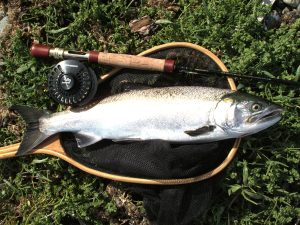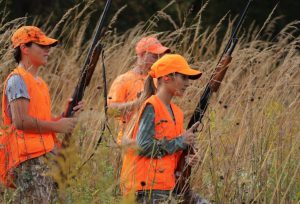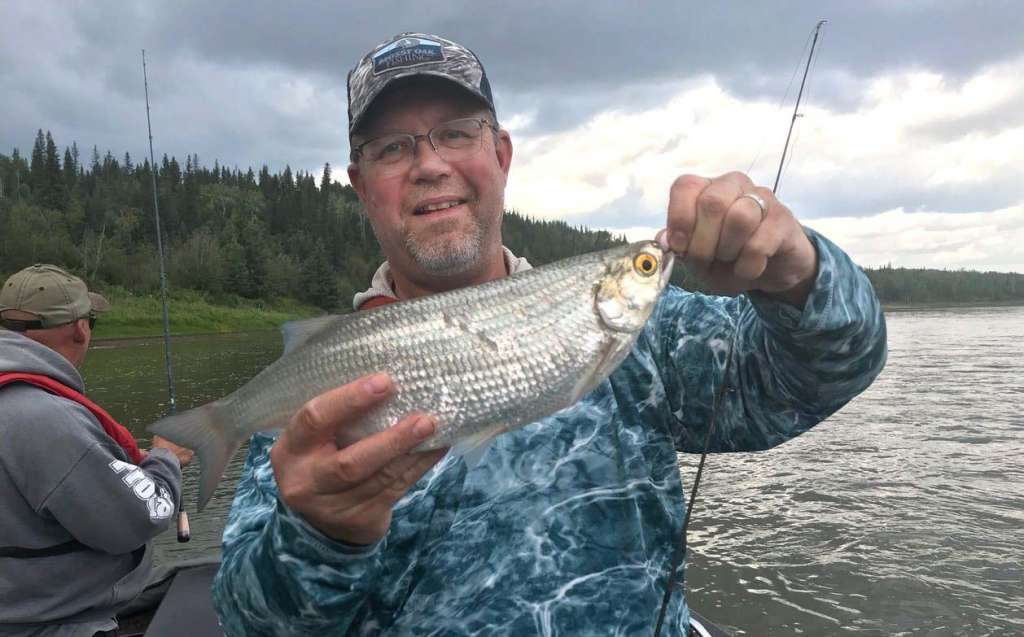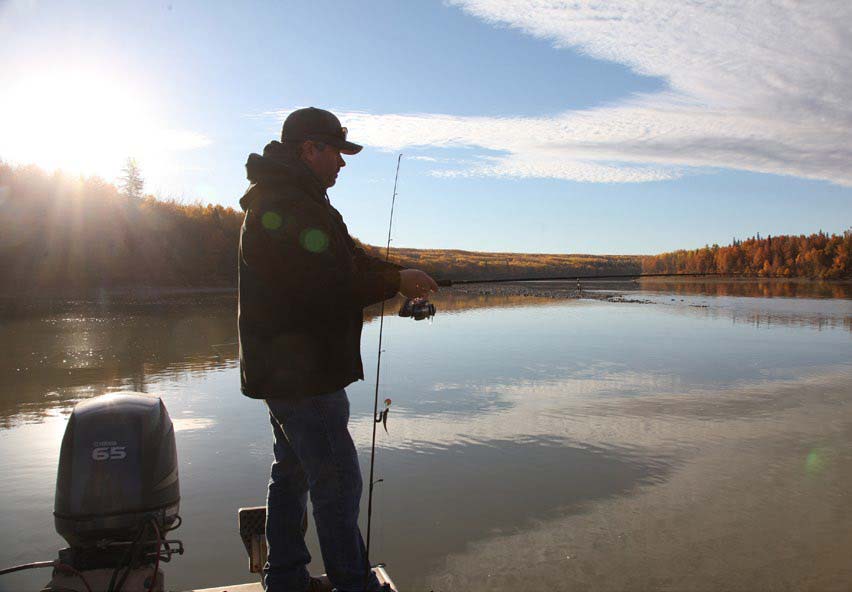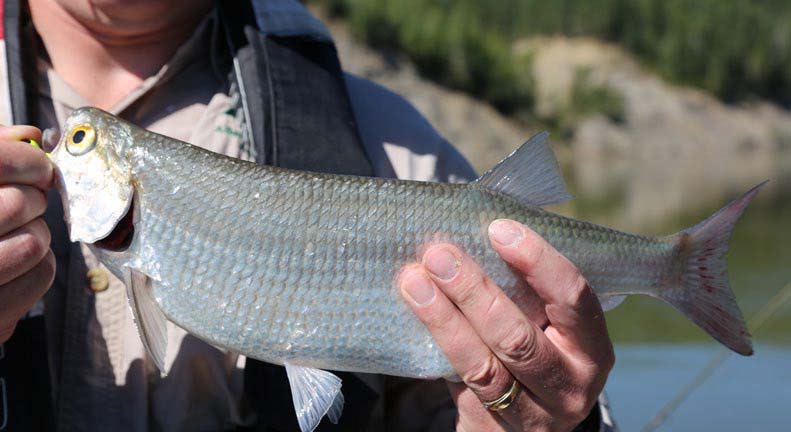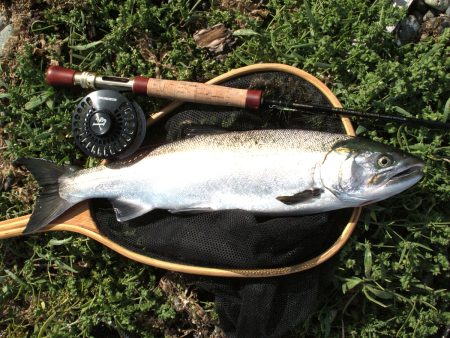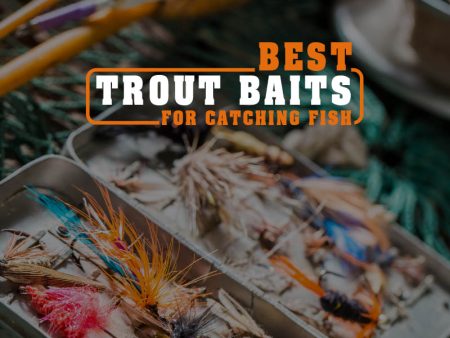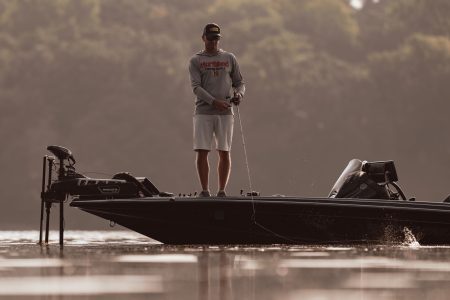The remote solitude of the Athabasca River is a special place to fish in late summer. I was fishing with Ray Kohlruss of Reel Angling Adventures (reelangling.com) and we were hoping to boat some big walleye. Ray introduced me to the Athabasca years ago, and it is still a favorite destination for big fish.
Fishing a deep pool along a muddy shoreline we were treated to a couple of nice walleye, increasing our expectation of landing a lunker. The graphite fishing rod I held telegraphed the message that a fish had taken the minnow on the hook and with a subtle lift of the rod, it was game on.
The fish fought frantically, using the current to its advantage, pulling line off the reel. The battle was intense with erratic head shakes and violent surges to stay away from the boat. As the fish neared the surface, we caught a flash of yellow and bright silver, yelling “it’s a goldeye”.
With the jig firmly hooked in the jaw of the fish, we landed the freshwater warrior and had a closer look. The body was deep, but the profile of the fish was thin, making it built for flowing water. A blunt head was preloaded with a mouth full of teeth that gave the fish the appearance of a piranha. It was easy to tell where the goldeye generated its strength, with a deep-forked tail that operated as a high-end transmission. The anal fin is long and tapered to work as a powerful rudder to manipulate current and move on a dime.
It wasn’t the first time we had caught goldeye in the river, but it was the first of the season. We boated dozens of the silver torpedoes during the day and almost forgot about the walleye. We kept some of the delicately fleshed goldeye for smoking, as they are considered a delicacy when prepared properly. You can stroll into old world butcher shops in Manitoba and still buy smoked goldeye commercially harvested from the large lakes in that province. Truth be known, few anglers embrace this aggressive sportfish for the table or the sporting action they provide.
Where
Goldeye are present in lakes in rivers and prefer turbid water, so the river systems in Alberta provide the ideal medium for this predatory fish to exist. They are spring spawners and look for rocky or gravely bottoms, with slow current, meaning they are not in the main river channels with surging currents from spring runoff. Young goldeye hang out in the slower water until three or four years of age, when they will make their first foray to the main river channels. The adult fish start showing up in June and remain active feeders through the fall.
They inhabit shallow and deep pools and hug the current lines to use it as a food trough to make finding a meal easy.
How
Goldeye are extremely adaptable and eat everything from insects and crayfish to other fish. Anglers that have never targeted goldeye are really missing out on one of Alberta’s most aggressive sportfish.
Goldeye can be caught on the bottom of the river using a jig and minnow or leech, and even crankbaits are effective to entice a strike. Fly anglers will enjoy the aggressive nature of this fish on the surface or with a sinking line. Grasshopper patterns are a great option in mid-summer when goldeye are actively looking for hoppers that have fallen into the river. You don’t have to be an accomplished fly angler to catch these fish, making them a wonderful species for the beginner.
If there was ever a fish meant for kids, it must be goldeye. A bobber and worm, grasshopper, leech, minnow, or other smelly bait are sure to entice a strike during the time of year when the fish are in Alberta’s major river systems. An evening on the river bank will often generate dozens of hookups and who doesn’t like fishing a bobber for the visual entertainment and heart-pounding action?
The best-kept secret about goldeye is the way they fight. They have the tenacity of a big, old northern, but fight with the strength and stamina of a trout from cold water. They are not overly subtle when they strike, and once they feel a hook, they never quit trying to escape. It can often be difficult to land goldeye because of their acrobatic attempts to throw the hook.
Goldeye grow to about four pounds, and it isn’t uncommon to catch plenty of adult fish when fishing main river channels.
When
The first goldeye I ever encountered was in Sturgeon River on a spring fishing foray. I was casting a jig and leech, hoping to catch a walleye when I inadvertently discovered goldeye. The goldeye garners little respect from most anglers and is often overlooked for its attributes. There are only a handful of fishermen and women that target these fish, and they seldom talk about it, making it seem like a secret society of goldeye anglers.
Mature fish will migrate long distance on an annual basis, meaning one day they are plentiful and the next day they aren’t. Over the years it has been interesting to watch the timing of goldeye migration. Are we catching them because we are presenting what they want to eat that time of year or have they been there the whole time and are only now just being selective in their diet?
Late summer and early fall have always been a favourite time to target goldeye. A good day will produce over 50 fish, and just when you think you’ve caught your biggest ever, an even larger one tends to show up. Goldeye congregate in good habitat, and it isn’t uncommon to catch several fish from the same location. A fish on the line often stirs the river up and can turn fish on to feed. The turbid water makes it difficult for the fish to see what’s going on, but with deep, flat sides they can feel and sense the movement of other fish. When you get a big one stirring up a deep pool with every move in the book to get away, it just triggers more goldeye to feed.
What
Goldeye have huge eyes to help them see in the turbid waters they hunt. They also have sensitive lateral lines that can pick up vibrations from a long way off. Their nostrils are well pronounced, and fishing with bait always seems to trigger more action.
Minnows, leeches, scented plastic baits, and other smelly baits create a scent stream in the river that goldeye will sense and follow. Get a jig and minnow to the bottom, and it is only a matter of time before one of them bites.
Spinners and crankbaits put off lots of vibration with blades or movement, which can also trigger goldeye. Do not underestimate the ability of goldeye to feel vibration and home in on your bait. Even spoons work well for attracting and catching fish. When fishing the rivers for walleye and pike we often have people vertically jigging and someone throwing a spoon. It never fails that the extra flash and vibration attract fish and most of the time the goldeye follow the spoon back to the boat where the jiggers catch them. My theory is the spoon is too big to eat, but the goldeye get excited all the same. They head for the bottom and smack dab into the bait being fished by other anglers.
Big spoons may be a hefty meal for most goldeye, but the smaller ones are dynamite. Colour, flash, and vibration are often the best approach for any river-dwelling fish species. It is unclear if there is a colour that works better than another, but brass and silver are always good choices, as they have lots of light-refracting capability. There is little doubt goldeye can see well in the mud-stained water, as they hit hooks squarely when targeted.
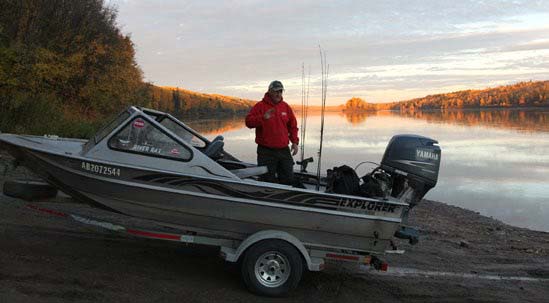
Steel-blue scales along the back, sterling silver sides, and a brilliant yellow eye make the goldeye unmistakable for anglers. The attractive features on this fish should attract hoards of anglers on its own, but they are like the Rodney Dangerfield of sportfishing in Alberta, meaning they garner “no respect”.
If you’re looking for a new angling challenge, target goldeye this season and see if you can figure them out from ice out, till freeze up. They are abundant, will lead you to some of the prettiest country in Alberta, and will keep a steady bend in your rod. If you want to get brave, try one as table fare. Smoked goldeye never lasts long around our house, and we try to do a batch at least once a year.
Keeping Fish?
If you plan on keeping goldeye for the table, there are a couple of recommendations. Do not freeze your catch, but rather utilize them fresh, as they are extremely delicate, and the flesh breaks down easily. Make sure to pack a cooler with ice to transport and store fish. The heat on even a cloudy day will quickly turn fish soft to the touch. Proper care and handling will ensure you have the best product for an honest taste test.
The Hi Mountain Brown Sugar or Gourmet Fish Brine kits are awesome for preparing dressed fish for the smoker. Don’t try to fillet goldeye, as their thin bodies make for thin fillets, and having the skin on the entire fish for smoking makes for a better end product. For a traditional look, gut, and gill the fish and smoke them head on. The golden eye takes on a unique appearance when smoked and is a dead giveaway for anyone that has enjoyed smoked goldeye.
By Brad Fenson
Per our affiliate disclosure, we may earn revenue from the products available on this page.

